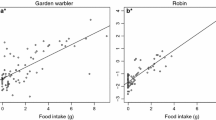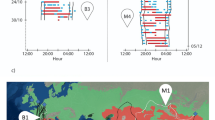Abstract
Time of departure and landing of nocturnal migrants are of great importance for understanding migratory strategy used by birds. It allows us to estimate flying time and hence the distance that migrants cover during a single night. In this paper, I studied the temporal schedule of nocturnal departures of European robins during spring migration. The study was done on the Courish Spit on the Baltic Sea in 1998–2003 by retrapping 51 ringed birds in high mist nets during nocturnal migratory departure. Take-offs of individual birds occurred between the first and tenth hour after sunset (median 176 min after sunset). Departure time was not related to fuel stores at arrival and departure, stopover duration and progress of the season. The results suggest that one reason for temporal variation in take-off time was differential response of European robins with high and low motivation to depart to such triggers as air pressure and its trend. If these parameters reach a certain minimum threshold shortly before sunset, robins with a high migratory motivation take off in the beginning of the night. When air pressure or its trend reaches a maximum, it may trigger to take off later during the night birds with lower initial motivation for departure, including those that have low refuelling efficiency. In regulation of timing of take-offs of robins, an important role is also played by their individual endogenous circadian rhythm of activity which is related to the environment in a complex way.




Similar content being viewed by others
References
Able KP (1989) Skylight polarization and the orientation of migratory birds. J Exp Biol 141:241–256
Able KP (1993) Orientation cues used by migratory birds: a review of cue–conflict experiments. Trends Ecol Evol 8:367–371
Åkesson S, Hedenström A (2000) Wind selectivity of migratory flight departures in birds. Behav Ecol Sociobiol 47:140–144
Åkesson S, Alerstam T, Hedenström A (1996) Flight initiation of nocturnal passerine migrants in relation to celestial orientation conditions at twilight. J Avian Biol 27:95–102
Åkesson S, Walinder G, Karlsson L, Ehnbom S (2001) Reed warbler orientation: initiation of nocturnal migratory flights in relation to visibility of celestial cues at dusk. Anim Behav 61:181–189
Åkesson S, Walinder G, Karlsson L, Ehnbom S (2002) Nocturnal migratory flight initiation in reed warble Acrocephalus scirpaceus: effect of wind on orientation and timing of migration. J Avian Biol 33:349–357
Alerstam T (1990) Bird migration. Cambridge University Press, Cambridge
Alerstam T, Lindström Å (1990) Optimal bird migration: the relative importance of time, energy and safety. In: Gwinner E (ed) Bird migration physiology and ecophysiology. Springer, Berlin, pp 331–351
Bairlein F, Jenni L, Kaiser A, Karlsson L, Noordwijk A, Peach W, Pilastro A, Spina F, Walinder G (1995) European–African songbird migration network: manual of field methods. ESF, Wilhelmshaven
Berthold P (1996) Control of bird migration. Chapman and Hall, London
Berthold P (2001) Bird migration: a general survey, 2nd edn. Oxford University Press, Oxford
Biebach H (1985) Sahara stopover in migratory flycatchers: fat and food affect the time program. Experientia 41:695–697
Bolshakov CV (1992) Evening movements of the nocturnal migratory flight in the fieldfare (Turdus pilaris): preliminary results. In: Payevsky VA (ed) Problems of birds’ population ecology (in Russian). Proc Zool Inst 247:18–42
Bolshakov CV, Bulyuk VN (1999) Time of nocturnal flight initiation (take-off activity) in the European robins Erithacus rubecula during spring migration: direct observation between sunset and sunrise. Avian Ecol Behav 2:51–74
Bolshakov CV, Bulyuk VN (2001) New comprehensive systematic data concerning the time of nocturnal departure in some passerine migrants in autumn. Ring 23:131–137
Bolshakov CV, Chernetsov N (2004) Initiation of nocturnal flight in two species of long-distance migrants (Ficedula hypoleuca and Acrocephalus schoenobaenus) in spring: a telemetry study. Avian Ecol Behav 12:63–76
Bolshakov CV, Bulyuk VN, Sinelschikova A (2000) Study of nocturnal departures in small passerine migrants: retrapping of ringed birds in high mist-nets. Vogelwarte 40:250–257
Bolshakov CV, Bulyuk VN, Chernetsov N (2003a) Spring nocturnal migration of reed warblers Acrocephalus scirpaceus: departure, landing and body condition. Ibis 145:106–112
Bolshakov CV, Bulyuk VN, Mukhin A, Chernetsov N (2003b) Body mass and fat reserves of sedge warblers during vernal nocturnal migration: departure versus arrival. J Field Ornithol 74(1):81–89
Bolshakov CV, Mukhin A, Chernetsov N, Bulyuk VN, Kosarev V, Ktitorov P, Leoke D, Tsvey A (2007) Time of nocturnal departures in European robins, Erithacus rubecula, in relation to celestial cues, season, stopover duration and fat stores. Anim Behav 74:855–865
Bulyuk VN (2006) At what time of the day do passerine nocturnal migrants arrive at their breeding sites? Ardea 94:132–139
Bulyuk VN, Tsvey A (2006) Timing of nocturnal autumn migratory departures in juvenile European robins (Erithacus rubecula) and endogenous and external factors. J Ornithol 147:289–309
Chernetsov N (2005) Spatial behavior of medium and long-distance migrants at stopovers studied by radio tracking. Ann NY Acad Sci 1046:1–11
Chernetsov NS (2010) Passerine migration: stopovers and flight. KMK Scientific, Moscow (in Russian)
Chernetsov N, Mukhin A (2006) Spatial behavior of European robins Erithacus rubecula during migratory stopovers: a telemetry study. Wilson J Ornithol 118:364–373
Dolnik VR (1975) Migratory disposition in birds. Nauka, Moscow (in Russian)
Dolnik VR (1995) Energy and time resources in free-living birds. Nauka, St. Petersburg (in Russian)
Ehnbom S, Karlsson L, Ylven R, Akesson S (1993) A comparison of autumn migration strategies in robins, Erithacus rubecula, at a coastal and an inland site in southern Sweden. Ring Migr 14:94–93
Emlen ST (1980) Decision making by nocturnal bird migrants: the integration of multiple cues. In: Nohring R (ed) Acta International Ornithological Congress. Deutsche Gesellschaft, Berlin, pp 553–560
Goymann W, Spina F, Ferri A, Fusani L (2010) Body fat influences departure from stopover sites in migratory birds: evidence from whole-island telemetry. Biol Lett 6:478–481
Gwinner EH, Biebach H, von Kries I (1985) Food availability affects migratory restlessness in caged garden warblers (Sylvia borin). Naturwissenschaften 172:51–52
Gwinner EH, Schwabl H, Schwabl-Benzinger I (1988) Effects of food deprivation on migratory restlessness and diurnal activity in the garden warbler Sylvia borin. Oecologia 77:321–326
Hebrard J (1971) The nightly initiation of passerine migration in spring: a direct visual study. Ibis 113:8–18
Helbig AJ (1991) Are orientation mechanisms among migratory birds species-specific? Trends Ecol Evol 5:365–367
Hosmer DW, Lemeshow S (1989) Applied logistic regression. Wiley, New York
Jenni L, Schaub M (2003) Behavioural and physiological reaction to environmental variation in bird migration: a review. In: Berthold P, Gwinner E, Sonnenschein E (eds) Bird migration. Springer, Berlin, pp 155–171
Jenni-Eiermann S, Jenni L (2003) Interdependence of flight and stopover in migrating birds: possible effect of metabolic constraints during refuelling on flight metabolism. In: Berthold P, Gwinner E, Sonnenschein E (eds) Bird migration. Springer, Berlin, pp 293–306
Kaiser A (1993) A new multi-category classification of subcutaneous fat deposits of songbirds. J Field Ornithol 64:246–255
Kerlinger P, Moore FR (1989) Atmospheric structure and avian migration. Curr Ornithol 6:109–142
Kreithen ML, Keeton WT (1974) Detection of changes in atmospheric pressure by the homing pigeon, Columba livia. J Comp Physiol 89:73–82
Mehlum F (1983) Resting time in migrating robins (Erithacus rubecula) during stop-over at the island Faeder. Outer Oslofjord Norway Fauna norv. Ser C Cinclus 6:62–72
Moore FR (1987) Sunset and the orientation behaviour of migrating birds. Biol Rev 62:65–86
Moore FR, Aborn DA (1996) Time of departure by summer tanagers (Piranga rubra) from a stopover site following spring trans-gulf migration. Auk 113:949–952
Moore FR, Smith RJ, Sandberg R (2005) Stopover ecology of intercontinental migrants. In: Greenberg R, Marra PP (eds) Birds of two worlds. Smithsonian Institution, Washington, pp 251–261
Pettersson J (1983) The autumn migration of the robin Erithacus rubecula at Ottenby (in Swedish with English summary). Var Fagelvarld 42:333–342
Rabøl J, Petersen FD (1973) Length of resting time in various night-migrating passerines at Hesselø, Southern Kattegatt, Denmark. Ornis Scand 4:33–46
Richardson WJ (1978) Timing and amount of bird migration in relation to weather: a review. Oikos 30:224–272
Richardson WJ (1982) Nocturnal landbird migration over southern Ontario, Canada: orientation vs. wind in autumn. In: Papi F, Wallraff HG (eds) Avian navigation. Springer, Berlin, pp 15–27
Richardson WJ (1990) Timing of bird migration in relation to weather: updated review. In: Berthold P, Gwinner E, Sonnenschein E (eds) Bird migration. Springer, Berlin, pp 79–101
Sandberg R (1991) Sunset orientation of robins, Erithacus rubecula, with different fields of sky vision. Behav Ecol Sociobiol 28:77–83
Sandberg R (2003) Stored fat and the migratory orientation of birds. In: Berthold P, Gwinner E, Sonnenschein E (eds) Avian migration. Springer, Berlin, pp 515–525
Schaub M, Jenni L (2000) Fuel deposition of three passerine bird species along the migration route. Oecologia 122:306–317
Schaub M, Jenni L, Bairlein F (2008) Fuel stores, fuel accumulation, and the decision to depart from a migration stopover site. Behav Ecol 19:657–666
Schmaljohann H, Becker PJJ, Karaardic H, Liechti F, Naef-Daenzer B, Grande C (2011) Nocturnal exploratory flights, departure time, and direction in a migratory songbird. J Ornithol 152:439–452
Stolt B-O (1969) Temperature and air pressure experiments on activity in passerine birds with notes on seasonal and circadian rhythms. Zool Bidr Uppsala 38:175–231
Szulc-Olech B (1965) The resting period of migrant Robins (Erithacus rubecula) on autumn passage. Bird Study 12:1–7
Terrill SB (1988) The relative importance of ecological factors in bird migration. In: Acta XIX Congressus Internationalis Ornithologici. Ottawa, pp 2180–2190
Titov N (1999a) Individual home ranges in robins Erithacus rubecula at stopovers during autumn migration. Vogelwelt 120:237–242
Titov N (1999b) Home ranges in two passerine nocturnal migrants at a stopover site in autumn. Avian Ecol Behav 3:69–78
Tsvey A (2008) Migratory strategy of robins (Erithacus rubecula) in Eastern Baltic. Ph.D. dissertation. Zoological Institute, Saint-Petersburg (in Russian)
Tsvey A, Bulyuk VN, Kosarev V (2007) Influence of body condition and weather on departures of first-year European robins, Erithacus rubecula, from an autumn migratory stopover site. Behav Ecol Sociobiol 61:1665–1674
Zimin VB (2003) Body mass variability in juvenile robins Erithacus rubecula in the Ladoga area. Avian Ecol Behav 10:1–31
Acknowledgments
I am most grateful to my colleagues Arseny Tsvey for his assistance in the field and Nikita Chernetsov for correcting the English and many valuable remarks. I am indebted to many colleagues and students who caught birds at daytime and helped to install the high nets. I thank two anonymous reviewers who helped me greatly improve the manuscript. The author acknowledges the British Atmospheric Data Centre (BADC) for providing wind balloon data. This study was supported by the Russian Foundation for Basic Research (grant 04-04-49161). The methods used in this study comply with the laws of the Russian Federation.
Author information
Authors and Affiliations
Corresponding author
Additional information
Communicated by W. Wiltschko
Rights and permissions
About this article
Cite this article
Bulyuk, V.N. Influence of fuel load and weather on timing of nocturnal spring migratory departures in European robins, Erithacus rubecula . Behav Ecol Sociobiol 66, 385–395 (2012). https://doi.org/10.1007/s00265-011-1284-1
Received:
Revised:
Accepted:
Published:
Issue Date:
DOI: https://doi.org/10.1007/s00265-011-1284-1




